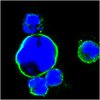Nbs1 ChIP-Seq Identifies Off-Target DNA Double-Strand Breaks Induced by AID in Activated Splenic B Cells.
Khair, L; Baker, RE; Linehan, EK; Schrader, CE; Stavnezer, J
PLoS genetics
11
e1005438
2015
Show Abstract
Activation-induced cytidine deaminase (AID) is required for initiation of Ig class switch recombination (CSR) and somatic hypermutation (SHM) of antibody genes during immune responses. AID has also been shown to induce chromosomal translocations, mutations, and DNA double-strand breaks (DSBs) involving non-Ig genes in activated B cells. To determine what makes a DNA site a target for AID-induced DSBs, we identify off-target DSBs induced by AID by performing chromatin immunoprecipitation (ChIP) for Nbs1, a protein that binds DSBs, followed by deep sequencing (ChIP-Seq). We detect and characterize hundreds of off-target AID-dependent DSBs. Two types of tandem repeats are highly enriched within the Nbs1-binding sites: long CA repeats, which can form Z-DNA, and tandem pentamers containing the AID target hotspot WGCW. These tandem repeats are not nearly as enriched at AID-independent DSBs, which we also identified. Msh2, a component of the mismatch repair pathway and important for genome stability, increases off-target DSBs, similar to its effect on Ig switch region DSBs, which are required intermediates during CSR. Most of the off-target DSBs are two-ended, consistent with generation during G1 phase, similar to DSBs in Ig switch regions. However, a minority are one-ended, presumably due to conversion of single-strand breaks to DSBs during replication. One-ended DSBs are repaired by processes involving homologous recombination, including break-induced replication repair, which can lead to genome instability. Off-target DSBs, especially those present during S phase, can lead to chromosomal translocations, deletions and gene amplifications, resulting in the high frequency of B cell lymphomas derived from cells that express or have expressed AID. | | | 26263206
 |
Genome-wide binding of MBD2 reveals strong preference for highly methylated loci.
Menafra, R; Brinkman, AB; Matarese, F; Franci, G; Bartels, SJ; Nguyen, L; Shimbo, T; Wade, PA; Hubner, NC; Stunnenberg, HG
PloS one
9
e99603
2014
Show Abstract
MBD2 is a subunit of the NuRD complex that is postulated to mediate gene repression via recruitment of the complex to methylated DNA. In this study we adopted an MBD2 tagging-approach to study its genome wide binding characteristics. We show that in vivo MBD2 is mainly recruited to CpG island promoters that are highly methylated. Interestingly, MBD2 binds around 1 kb downstream of the transcription start site of a subset of ∼ 400 CpG island promoters that are characterized by the presence of active histone marks, RNA polymerase II (Pol2) and low to medium gene expression levels and H3K36me3 deposition. These tagged-MBD2 binding sites in MCF-7 show increased methylation in a cohort of primary breast cancers but not in normal breast samples, suggesting a putative role for MBD2 in breast cancer. | | Human | 24927503
 |
Timing of transcriptional quiescence during gametogenesis is controlled by global histone H3K4 demethylation.
Xu, M; Soloveychik, M; Ranger, M; Schertzberg, M; Shah, Z; Raisner, R; Venkatasubrahmanyan, S; Tsui, K; Gebbia, M; Hughes, T; van Bakel, H; Nislow, C; Madhani, HD; Meneghini, MD
Developmental cell
23
1059-71
2012
Show Abstract
Gametes are among the most highly specialized cells produced during development. Although gametogenesis culminates in transcriptional quiescence in plants and animals, regulatory mechanisms controlling this are unknown. Here, we confirm that gamete differentiation in the single-celled yeast Saccharomyces cerevisiae is accompanied by global transcriptional shutoff following the completion of meiosis. We show that Jhd2, a highly conserved JARID1-family histone H3K4 demethylase, activates protein-coding gene transcription in opposition to this programmed transcriptional shutoff, sustaining the period of productive transcription during spore differentiation. Moreover, using genome-wide nucleosome, H3K4me, and transcript mapping experiments, we demonstrate that JHD2 globally represses intergenic noncoding transcription during this period. The widespread transcriptional defects of JHD2 mutants are associated with precocious differentiation and the production of stress-sensitive spores, demonstrating that Jhd2 regulation of the global postmeiotic transcriptional program is critical for the production of healthy meiotic progeny. | Western Blotting | | 23123093
 |
Cdc14 phosphatase promotes segregation of telomeres through repression of RNA polymerase II transcription.
Clemente-Blanco, Andres, et al.
Nat. Cell Biol., 13: 1450-6 (2011)
2011
Show Abstract
Kinases and phosphatases regulate messenger RNA synthesis through post-translational modification of the carboxy-terminal domain (CTD) of the largest subunit of RNA polymerase II (ref. 1). In yeast, the phosphatase Cdc14 is required for mitotic exit(2,3) and for segregation of repetitive regions(4). Cdc14 is also a subunit of the silencing complex RENT (refs 5,6), but no roles in transcriptional repression have been described. Here we report that inactivation of Cdc14 causes silencing defects at the intergenic spacer sequences of ribosomal genes during interphase and at Y' repeats in subtelomeric regions during mitosis. We show that the role of Cdc14 in silencing is independent of the RENT deacetylase subunit Sir2. Instead, Cdc14 acts directly on RNA polymerase II by targeting CTD phosphorylation at Ser 2 and Ser 5. We also find that the role of Cdc14 as a CTD phosphatase is conserved in humans. Finally, telomere segregation defects in cdc14 mutants(4) correlate with the presence of subtelomeric Y' elements and can be rescued by transcriptional inhibition of RNA polymerase II. | | | 22020438
 |


















